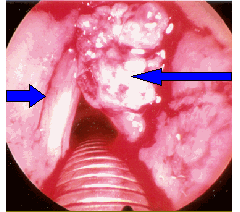HISTORICAL BACKGROUND:
In the mid-1980s, at the time this study began, three reports in the literature indicated that exposure to acid mists (mainly sulfuric acid) was associated with an increase of larynx cancer (Soskolne et al., 1984; Forastiere et al., 1988; Ahlborg et aI., 1981). However, these reports were inconclusive for several reasons:
- they were based on very small numbers,
- they lacked control over smoking, or,
they included people whose exposure to acid mists was uncertain.
 Hence, further study was warranted. The hypothesis that acid mists led to larynx cancer of the upper respiratory tract was biologically plausible. Acid mists irritate the epithelial cells of the upper respiratory tract and conceivably could be carcinogens. No animal studies had been done.
Hence, further study was warranted. The hypothesis that acid mists led to larynx cancer of the upper respiratory tract was biologically plausible. Acid mists irritate the epithelial cells of the upper respiratory tract and conceivably could be carcinogens. No animal studies had been done.
Investigators at the National Institute for Occupational Safety and Health (NIOSH) began to search for an appropriate population to study. The leading candidate was an existing cohort of 1,156 men exposed to acid mists during the pickling of steel. This cohort had already been studied for mortality by NIOSH investigators (Beaumont et al., 1987). The 1,156 men had worked at three midwestern steel plants from the 1940s through the 1980s. Their average duration of work in the pickling area was nine years.
Thirty-two percent of the acid mist cohort had died by 1985. The mortality study results had shown an excess of lung cancer. Regarding larynx cancer, two deaths had been observed versus one expected.
Acid pickling is done to remove impurities, and in this cohort the primary acid used was sulfuric acid. Exposures to sulfuric acid had generally been below the OSHA standard of 1.0 mg.m-3, and had changed little over time. Industrial hygiene sampling data showed no other occupational exposures to known carcinogens, such as nickel or chromium. Men with any coke oven exposure, which might increase the risk of larynx cancer, had been excluded from the cohort.
QUESTIONS
After considering the above, try and answer the following questions:
- QUESTION 1 a. What are the drawbacks of a mortality study of larynx cancer?
- QUESTION 1 b. What study design could be used to study larynx cancer among these steelworkers? What would be the nonexposed comparison group?
- QUESTION 1 c. Would such a study be worthwhile? This question should be addressed from the standpoint of statistical power, of public health, and of scientific/biologic interest.
- QUESTION 1 d. What are the principal known causes of larynx cancer? How could these other causes (potential confounders) be "controlled"?
 Hence, further study was warranted. The hypothesis that acid mists led to larynx cancer of the upper respiratory tract was biologically plausible. Acid mists irritate the epithelial cells of the upper respiratory tract and conceivably could be carcinogens. No animal studies had been done.
Hence, further study was warranted. The hypothesis that acid mists led to larynx cancer of the upper respiratory tract was biologically plausible. Acid mists irritate the epithelial cells of the upper respiratory tract and conceivably could be carcinogens. No animal studies had been done.